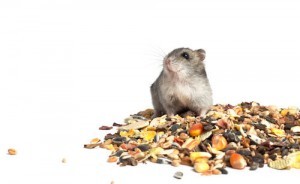Tips on Preventing A Hamster Illness
A good way to combat hamster illnesses is to prevent it from happening in the first place. With just a bit of preventative care, it can help you keep your pet healthy for much less than it would cost if your hamster actually gets sick. Here are a few hamster care recommendation that will go a long way in the health of your pet and hopefully save you a trip to the vet.
Related: Hamster Vet Care | Spot Signs of Illness
Provide a Healthy Diet
A well rounded diet will encourage strong bones and a healthy immune. If your hamster community tends to have a shorter lifespan than what should be expected and it’s not due to any visible illnesses, try changing their food. Your hamsters can be suffering from a vitamin deficiency.

Avoid Dehydration
Water is another vital part of keeping it healthy. This is especially the case for females that are nursing and young baby hamsters. If these newborns don’t get enough water, their growth can become stunted and won’t be as healthy when they mature. You can provide young hamsters with food that has a high concentration of water like pieces of fruit. It’s also important to make sure the hamster water bottle is within their reach.

A Comfy Habitat Reduces Illness
- Avoid choosing a hamster cage location that would cause any cold drafts from windows or air-conditioning units. If a hamster get the chills, it can lead to a weaker immune system.
- Keep the humidity and dampness to a minimum inside your hamster’s cage. In the wild, hamsters live in low humidity locations.
- Provide plenty of hiding places for your hamsters to hide in. This will reduce stress and increase their comfort level. A happy hamster is a healthy hamster.
- Make sure the toys you provide are hamster friendly. It’s important to know if a hamster chews and swallows bits of its toys that it won’t get ill from it.
- Provide plenty of space for your hamsters to spread out to avoid physical confrontations that can lead to open wounds or hamster abscesses that don’t heal.
- It’s important to place plenty of exercise options inside your hamster’s habitat. If your hamster is in shape and not bored it will decrease the risk of odd hamster behaviors.
- Setup your hamster habitat in a way that will keep your hamsters from falling, getting stuck or being cut by any of their hamster accessories.
Reviewed By: Tim Winter


Tim Winter has a strong affection for pets and wildlife. His years of experience caring for various types of pets has led him to share his knowledge with others on the best practices in pet care. Tim holds a Bachelor of Science from the University of Oregon School of Journalism and Communications.

Would it be ok to have my fan blowing in my bedroom at night away from my hamster?
I am getting a Syrian hamster next week and I’m super exited! I got a big cage with a second level, (if you are wondering which one it is it’s called ferplast Laura small animal cage or small Syrian hamster cage. It has a pink base)
And it has a tube. Will my hamster be able to excape out of the tubes if they come loose? Also, I was told not to put any wood chips on the second floor. This is correct, isn’t it? Only on the bottom floor, right?
i relly want to know is my hamster going to be ok beacause she will never move or run in here ball or wheel see is always sleeping please will she be ok???? i am scard for her!!!!
\
My hamster was running in my bathtub that was wiped down in bleach is he going to be okay because I am very scared and concerned
Justixe it is best if you use pet safe disinfectant to clean the inside of your bathtube as the bleach may be a bit too strong. But apart from that, it should be ok for your hamster to run around in the bathtub
I read above that I should make sure the hamsters don’t fall. That being said, my hamster climb all over the inside of the cage. They go up the sides and even climb on the ceiling of it. A good portion of the time they just fall off. How serious is this and how can i prevent it?
If you have soft bedding, it might not be a big concern. The only way to stop them from climbing is to have a cage with vertical bars so they have a harder time climbing up. Or you could try a different type of habitat like a glass tank or plastic module one.
I have 2 hamsters they fall all the time despite their delicate bones it depends where they fall from what they fall onto how hard they fell and how bad the hit if it’s a small one their fine if it’s medium check on them a bit more and large take them to the vet and get a cage that prevents injures!
If you have wood chips then it is fine for the hamster to fall into them as the wood chips provide a soft landing. Again, the best way is to get horizontal bars for the cage.
If your hamster is constantly climbing on the door of the cage then it probably means your hamster is itching to go out of the cage for a run around! ?
My Hamster’s cage is fairly decent, but I’m going to Expand it soon. That lead’s me to Two question’s. When getting another Level of the cage, if there anything else I can use other then the Tube’s, and My Hamster cage has a “Natural nest” (It’s a round shapped nest made from twig’s, and bark, but it latch’s onto the bar’s of the Cage), And I was wondering if that was good for my Hamster?
Other than tubes, you can use ramps but be careful that you don’t leave spaces ope that your hamster can fall off of the ramp or second level. Hamsters don’t have the best depth perception. I think the natural nest is a fine hideout given it’s made out materials that are not toxic to them. Obviously cedar would be bad since it is toxic (not good for bedding either) but also see some of the other woods found on our post on hamster food. best of luck with your hamster cage expansion 🙂